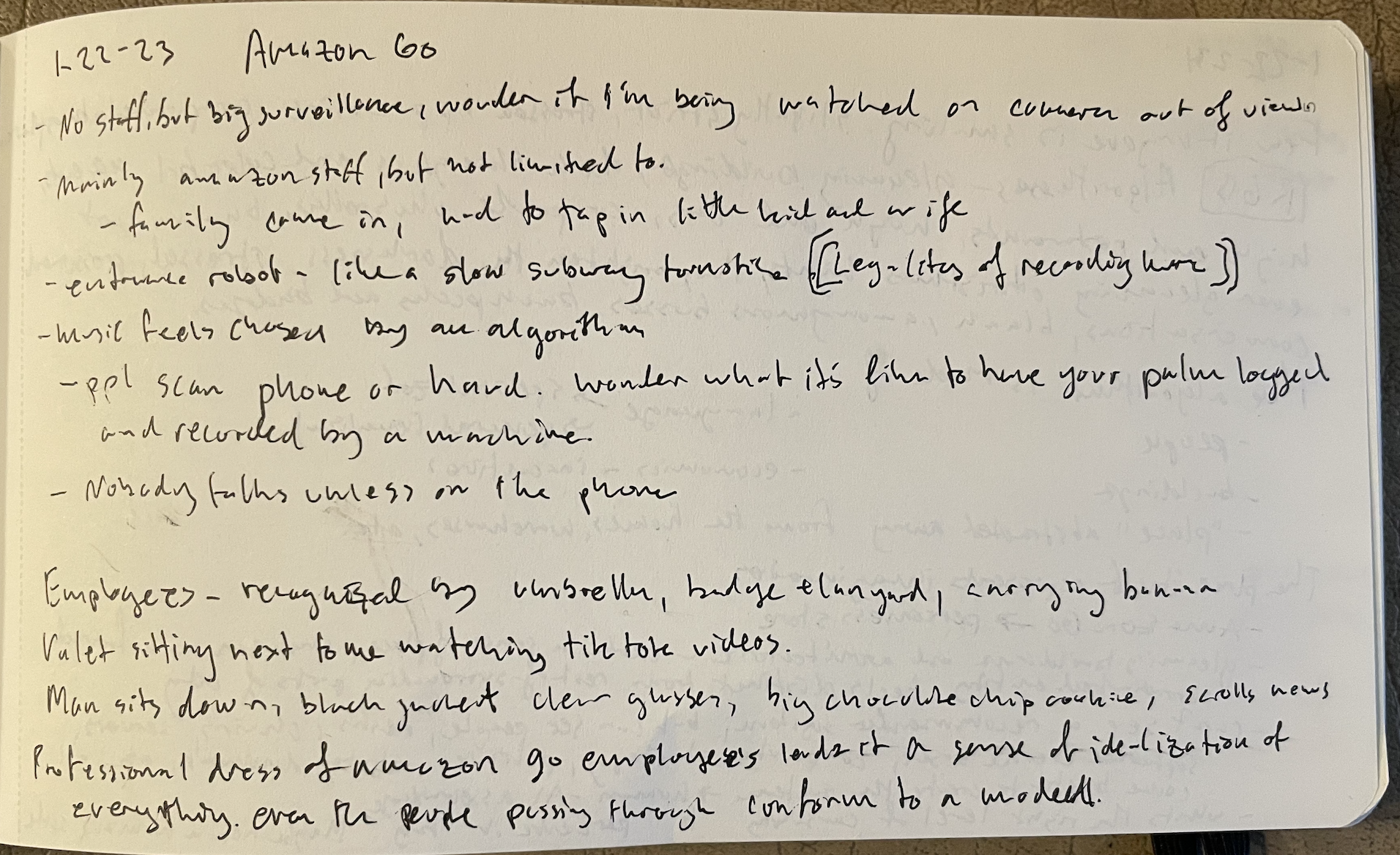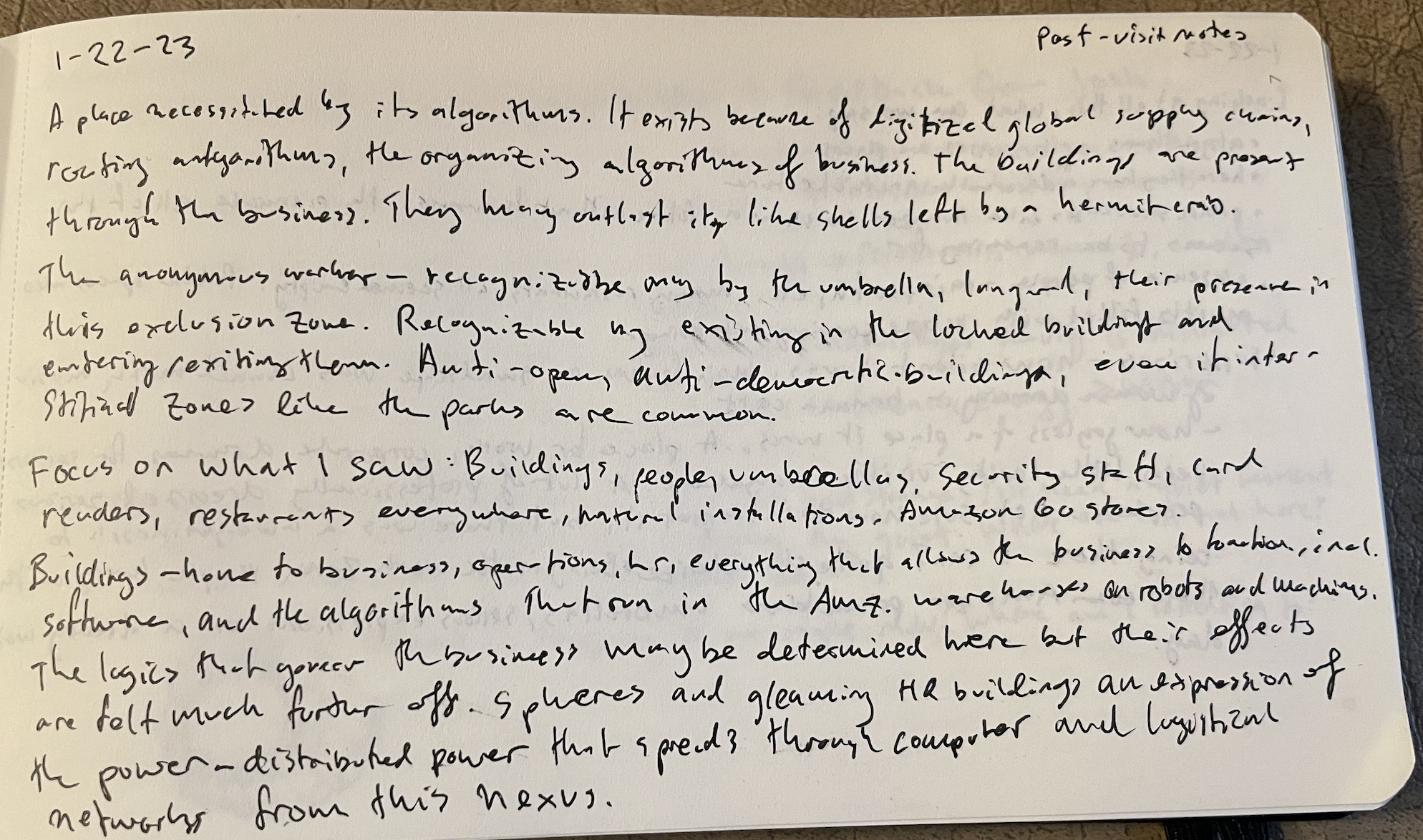Today I set out to view a nexus of algorithmic activity—the headquarters of Amazon and the emblematic structure—The Spheres (affectionately known as Bezos’ Balls here in Seattle). The purpose of the visit was to try to make visible the algorithms that I had also seen on the streets of New York City, the algorithms that route goods and recommend them on the web. The algorithms of Amazon Web Services (AWS) which underpin much of the internet’s core infrastructures. Given such intensive activity is concentrated in this place, I wondered how it would make itself visible in the space—this part of the city—and how the organizational “world” would be evident in a visible aesthetic and material way.
As I drove into downtown Seattle, buildings with the character of it’s historical growth—from the gold rush days to the booming 80s, gave way to a hub of gleaming (I’ll likely use this word a lot) dark-blue glass buildings with colorful accents. It was then I first saw the Spheres. As I searched for parking, I circled the block and saw that the entirety of it was these dark glass buildings. I finally found street parking across the street from the spheres, and parking cost $5/hour, twice as much as the usual rate for street parking!
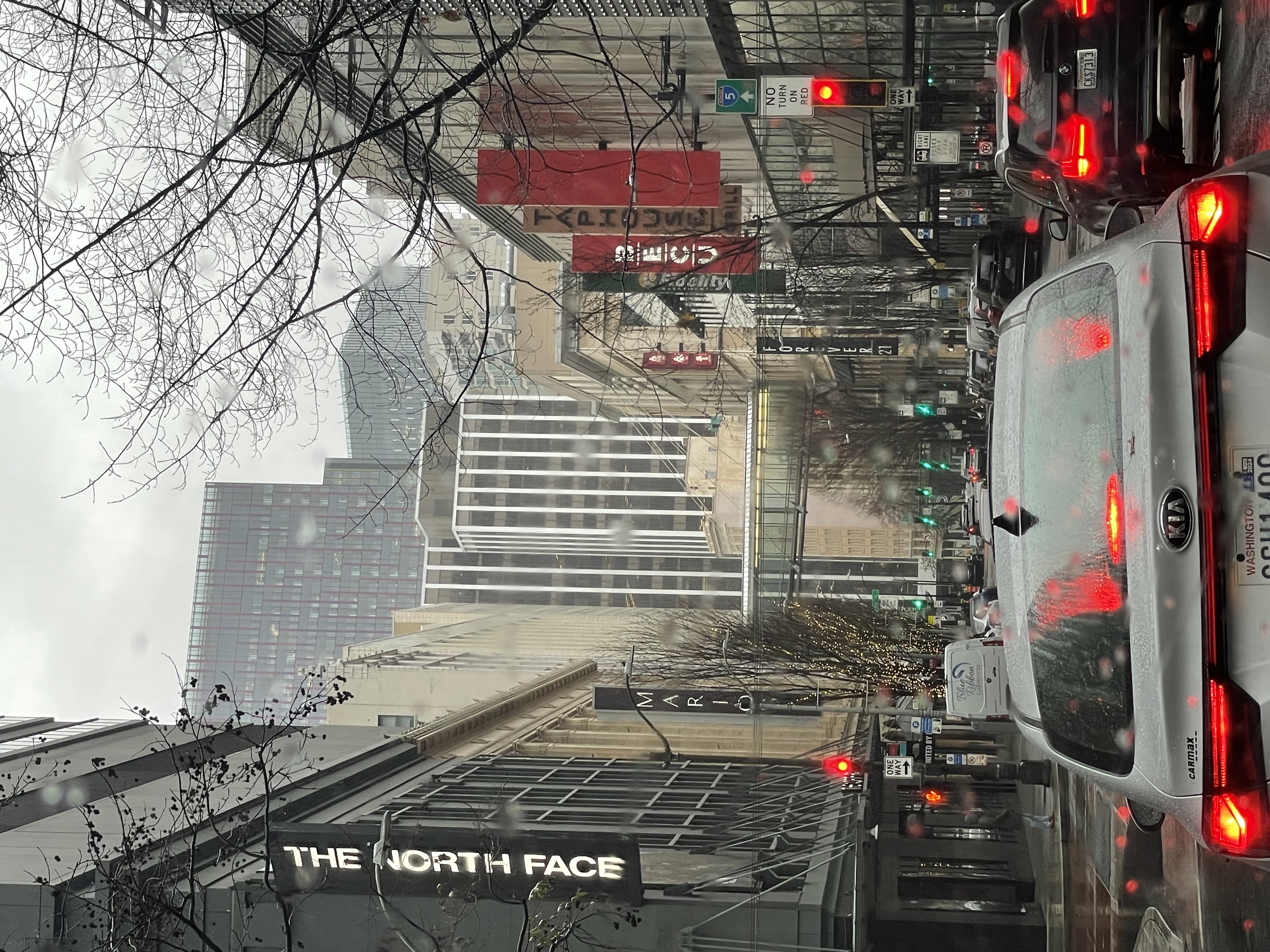
Seattle’s “usual” city scape of tans and greys, with the Amazon buildings looming high in the distance.
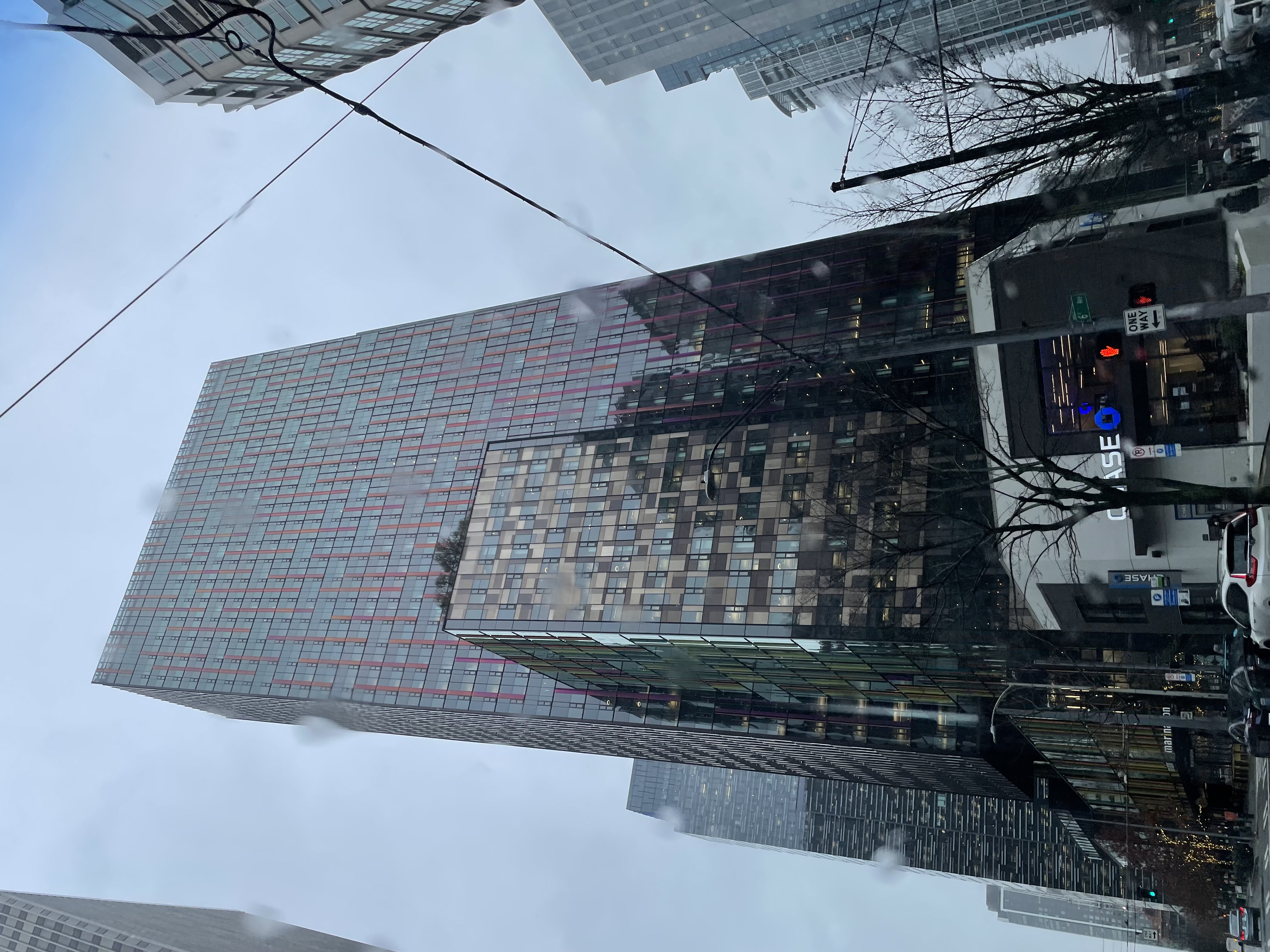
Initial snapshot of Amazon’s characteristic architecture. Dark glass building with colorful accents. The massing is rectangular. Notice the christmas lights that adorn trees on the street to the left in the photo.
As I stepped out of the car, I could see the spheres rising high above me. I took a photo, and immediately began to notice details.
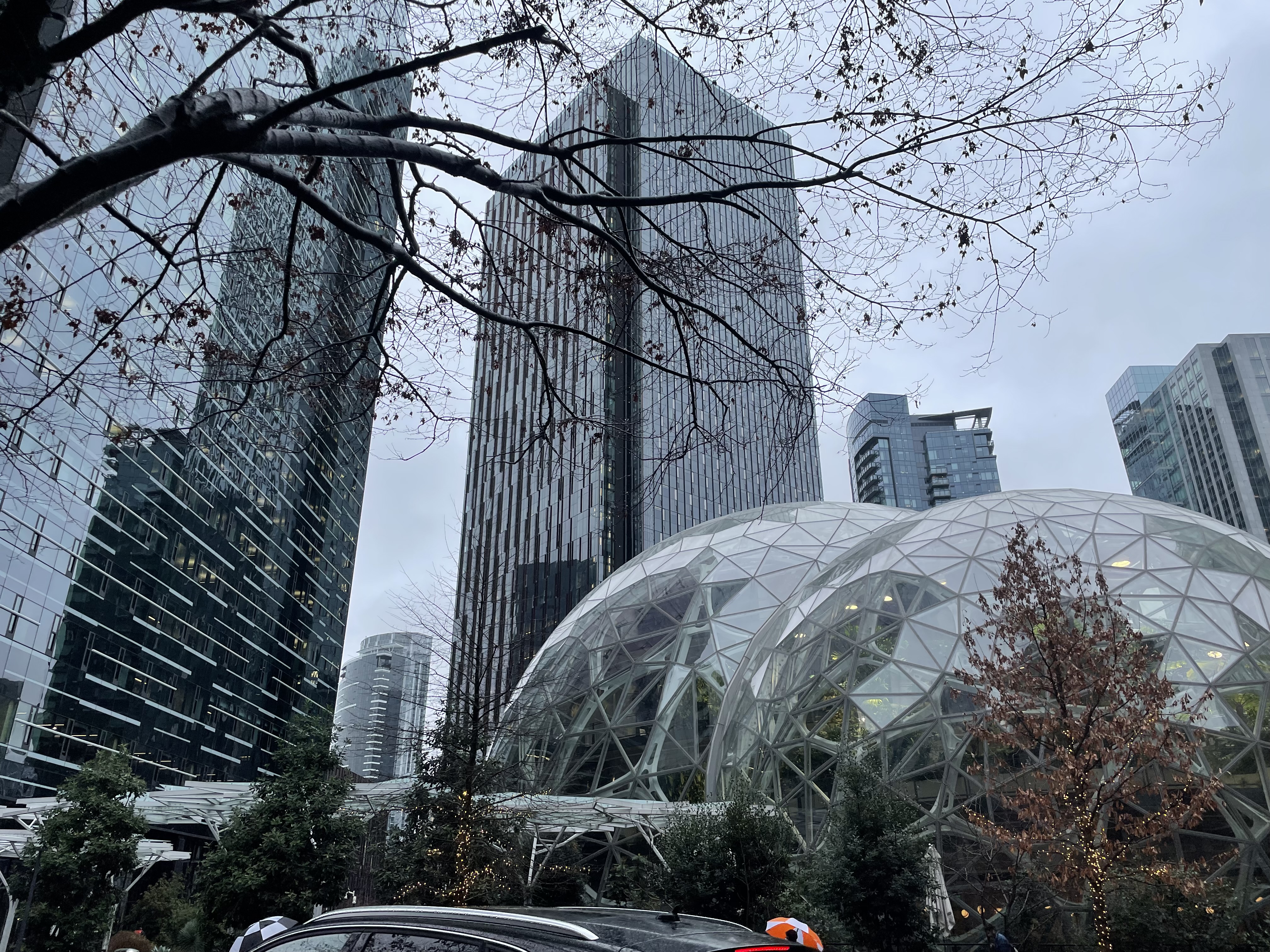
There was an emphasis on bringing in plant life and non human life. The spheres were surrounded by trees, including pine trees that still had christmas lights on them. Inside the spheres, there were more tropical seeming plants. Branching off the spheres there seemed to be a covered walk way. I was grateful for this, I thought, because it was raining and that would allow me a place to sit and observe without being covered in rain. I also noticed people standing with large colorful umbrellas—in the photo above it’s orange and white, but there were many other colors. Looking up, you can see the two large Amazon buildings and in the distance were equally new residential-seeming buildings. They suggested a density of population and work in this zone.
I began moving towards the crosswalk to approach the spheres, and took some more photos.
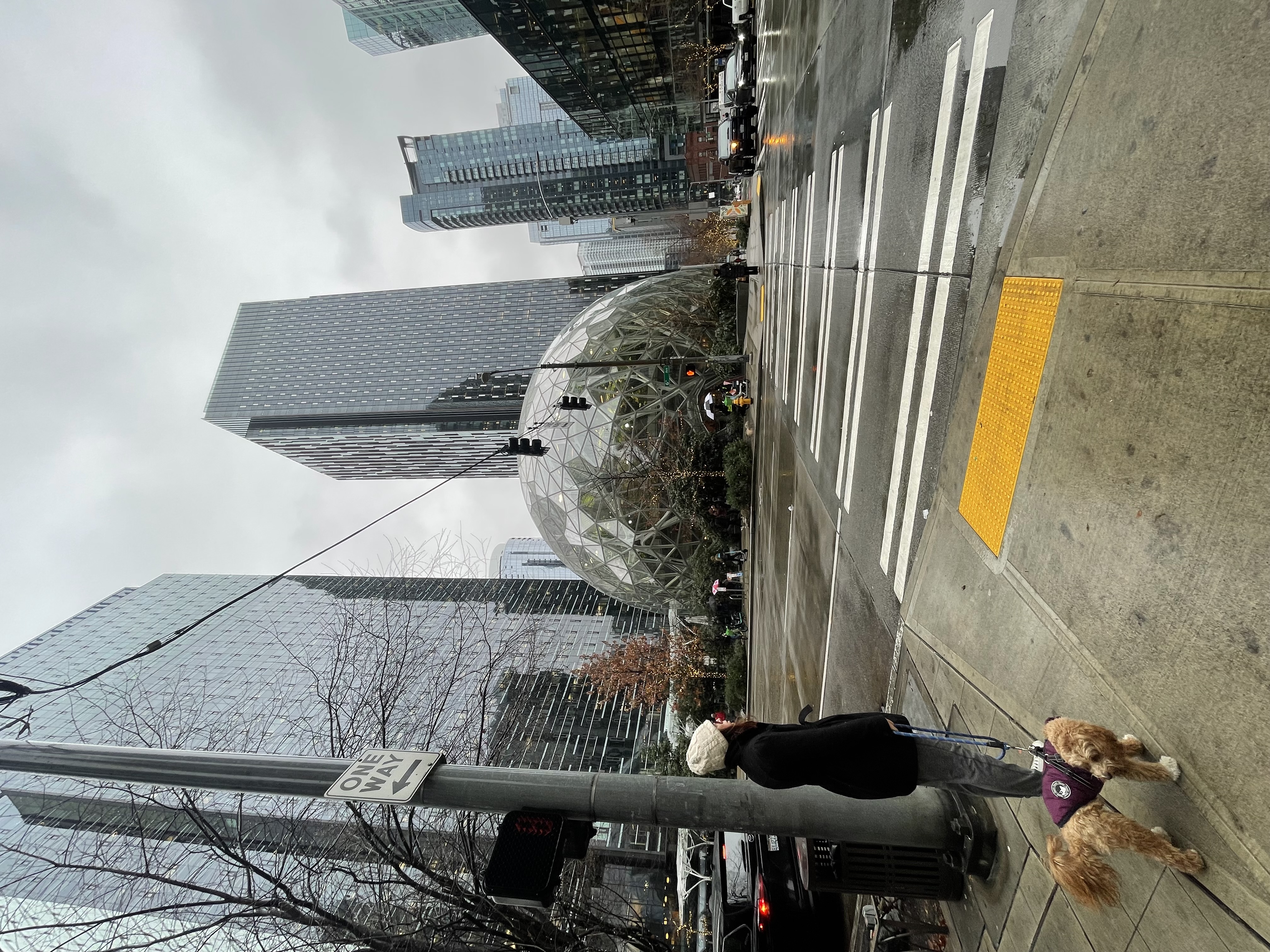
A woman-presenting person stands with a dog. I remembered that Amazon has a policy of allowing people to bring their dogs to work. I wasn’t sure about whether they are an employee, because there were no outward identifiers, but it then had me wondering: are they a resident going for a walk? an employee taking their dog out around lunchtime? otherwise are why they in this district of the city going for a walk with their dog in the middle of the day? Many questions, but none would be answered. This felt like a theme for this field notes expedition.
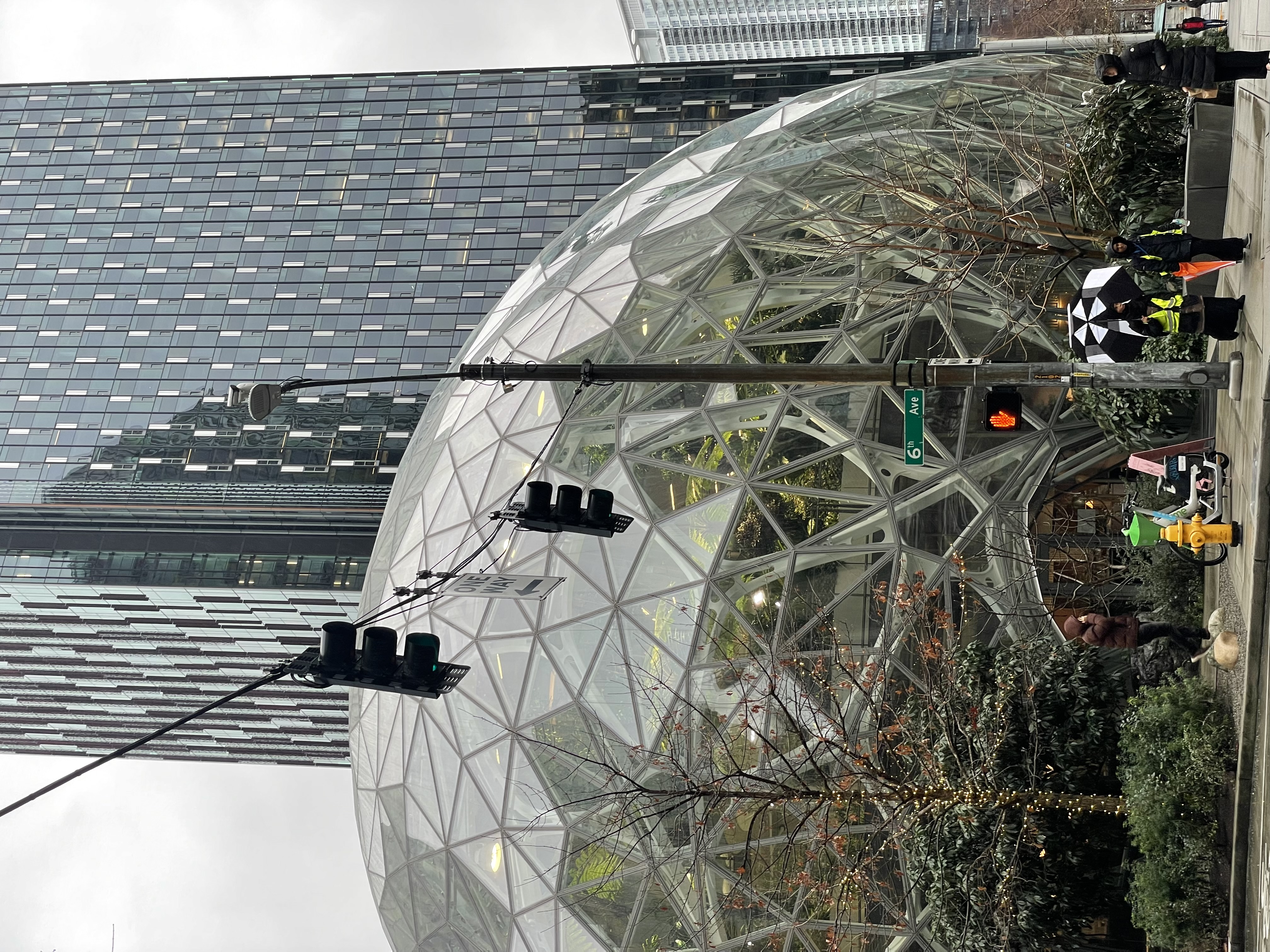
This photo reveals a number of details. In the foreground, the urban traffic infrastructure that looks almost anachronistic next to the glassy futurism of the spheres. We see the yellow fire hydrant, behind which are Lime bikes and electric scooters for hire. Standing to the right of the cross light are two employees wearing high vis vests and one is carrying a black and white umbrella. I wondered whether the color coding of the umbrella suggested that they were some kind of security or parking enforcement. We also see two other people both wearing hooded puffer coats.
Behind all this is the sphere—we get our most detailed look yet. There appears to be an entrance, in front of which is a pink placard. The structure of the sphere, white structural components beneath the glassy triangles seem to reveal an almost organic like structure that is surprisingly different from the rigidity and regularity of Buckminster fuller’s geodesic domes. While the basic idea of the glass dome may be inspired, the way the white structures bend and curve beneath the irregular pattern of glass polygons, seemed to suggest that there was a sophisticated algorithm at work: at once structural and information based, but one that defied easy surface registration of revealing its logic. Being somewhat versed in Voronoi triangulation but not structural engineering, I wondered whether they used an approach of constraint satisfaction, where structural constraints are determined and then an algorithm is run in order to satisfy the requirements. They often create strikingly naturalistic shapes that appear to look like fish bones or sea shell, and it wouldn’t have surprised me whether a similar technique was used. It comes together to create a kind of surface aesthetic that is at once retro-futurist—aren’t glass domes of the schemes and dreams of Buckminster fuller and 20th century sci-fi—while also being accelerated and intensified by phd-grade algorithms that might just as well have been invented by some of the professors who did computational design whom I studied under during my CS masters at UW. To me, the presence of these twisted and curved structures suggested a will, a desire, a hope for a “sci-fi future” made real through the capital accumulation of Amazon, its sophisticated technology and development capacity, and the dreams of the executives that are rooted in their childhood fascination with space colonization (cf. Bezos’s Blue Origin). The fact that these giant spheres are created to reflect the, potentially, libidinal desire of one supreme executive—Bezos, founder and former CEO—is likely why Seattlelites take great joy calling “The Spheres” the Bezos’ Balls.
Seattle itself is no stranger to seeing its city scape filled with the architecture of retrofuturism and Billionaire’s dreams. Whether it’s the Space Needle, the Monorail, the Experience Music Project, the Gates Foundation, or the myriad research institutes that occupy South Lake Union (adjascent to where I am), the city is littered with structures that reflect speculative dreams rooted in technoscience and popculture. Yet the spheres feel different, already, in part because they lie at the nexus of this impossibly vast corporate campus.
(could expand upon this, mentioning the SN is visible from the same site)
As I cross the street and get nearer, I feel no delight. I feel I’ve decidedly arrived in the present—an algorithmically mediated present where the residual accumulation of the vast tendrils that extend from this singular space have accumulated the capital to invest and complete a whole city block of gleaming black buildings (arguably far more impressive than the spheres themselves) alongside these spheres that now rise above me, whose irregular biology-inspired shape are not even spheres. (Perhaps they should be called bubbles? with all the connotations that brings: Bezos’ Bubbles!). As I reach the end of the crosswalk, I’m faced with a pink placquad:
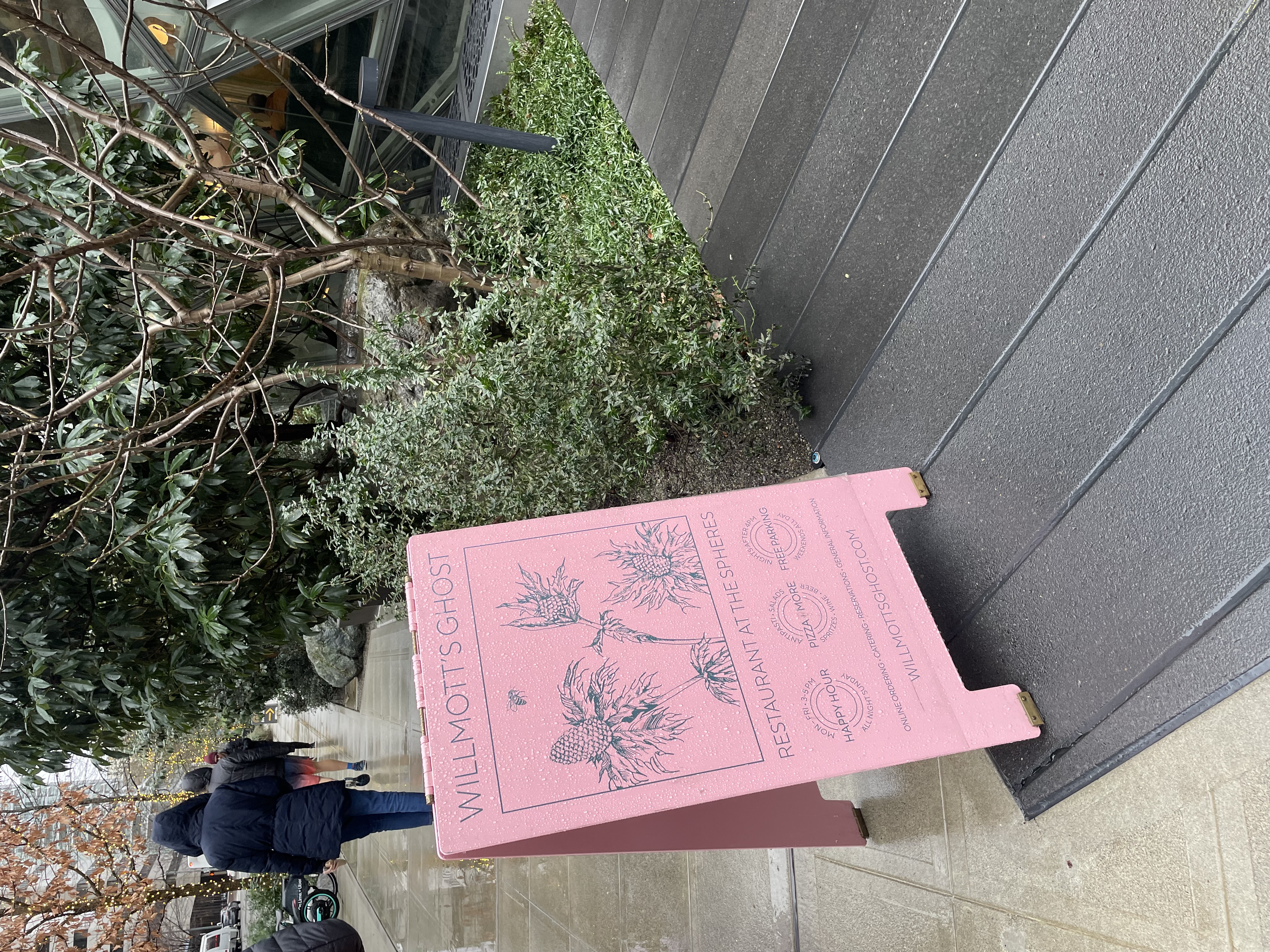
Personally, I found the use of typography and the hand sketched floral diagram to be fitting with a schtick that we are in the present and trying hard to normalize the sense that “yes you can have happy hour in the spheres.” I wondered who it was intended for? Tourists? Employees? Visiting business partners after a day’s visit at the Amazon HQ. It made me think about the extent to which this place, this nexus, sits at the center of Amazon’s global reach. I later, when passing by the spheres again, saw two dozen japanese businessmen and women exit the spheres in procession, each adorned with lanyards. It cemented to me the feeling that the spheres could act as a kind of architectural “nexus” at the heart of a vast global system, and yet was the work it was doing merely symbolic? What actually happend in the spheres? What deals are struck at Willmott’s Ghost? Wouldn’t it, maybe, be too on the nose to bring business guests out to drinks in the sphere? Then again, why would it be? I can’t untangle the protocol or logic of what work the spheres do yet, but I realized that through further observation of the spheres and their outlying zones perhaps I could begin to observe how human and algorithmic scales continue to intersect.
The placard beckoned towards the entrance, which I’ve photographed below:
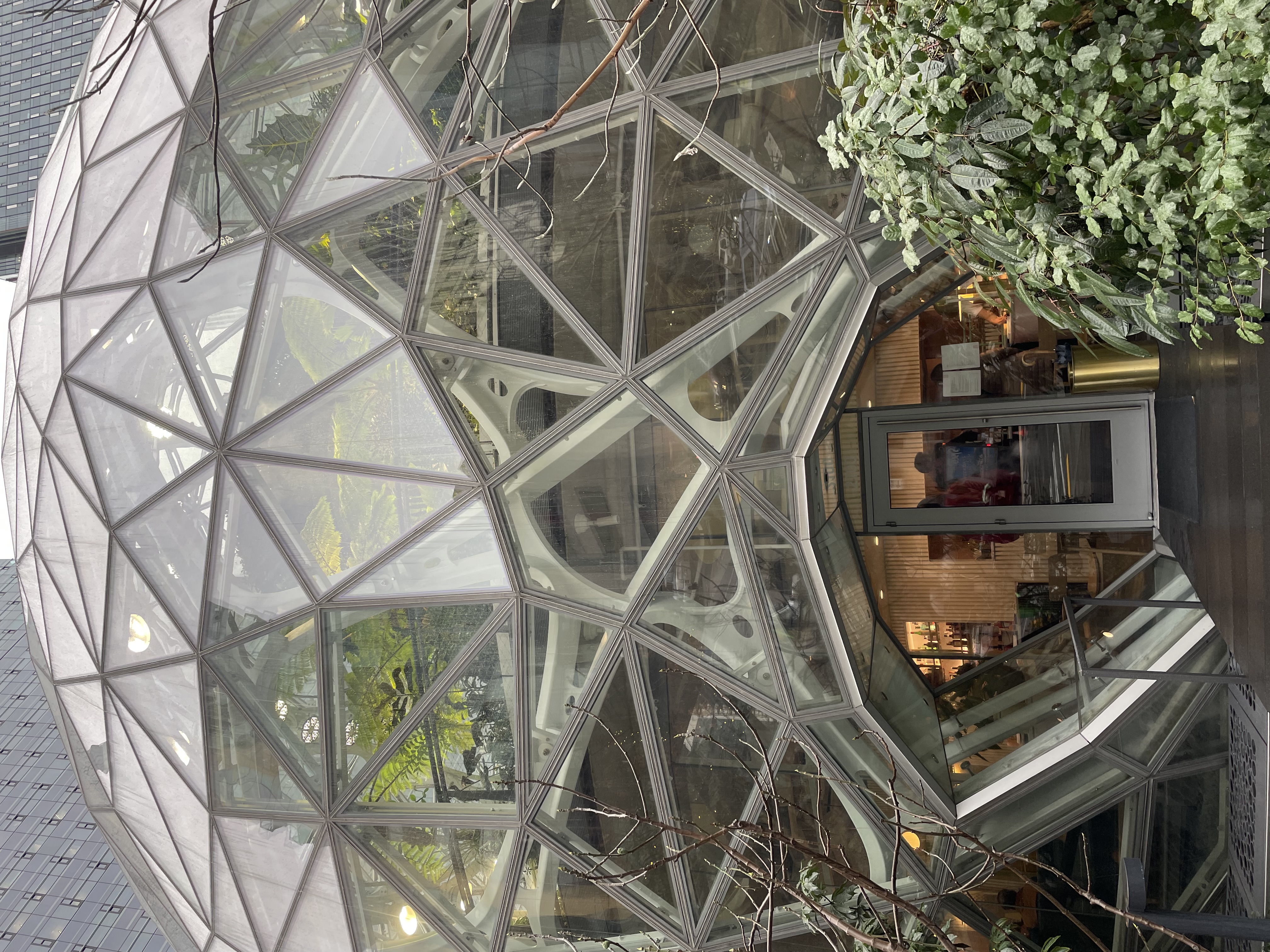
I got closer and noticed where was a buffet inside, along with an extensively stocked bar. I decided not to enter on this visit, and continue to the left, towards the covered area where I could hopefully take a seat.
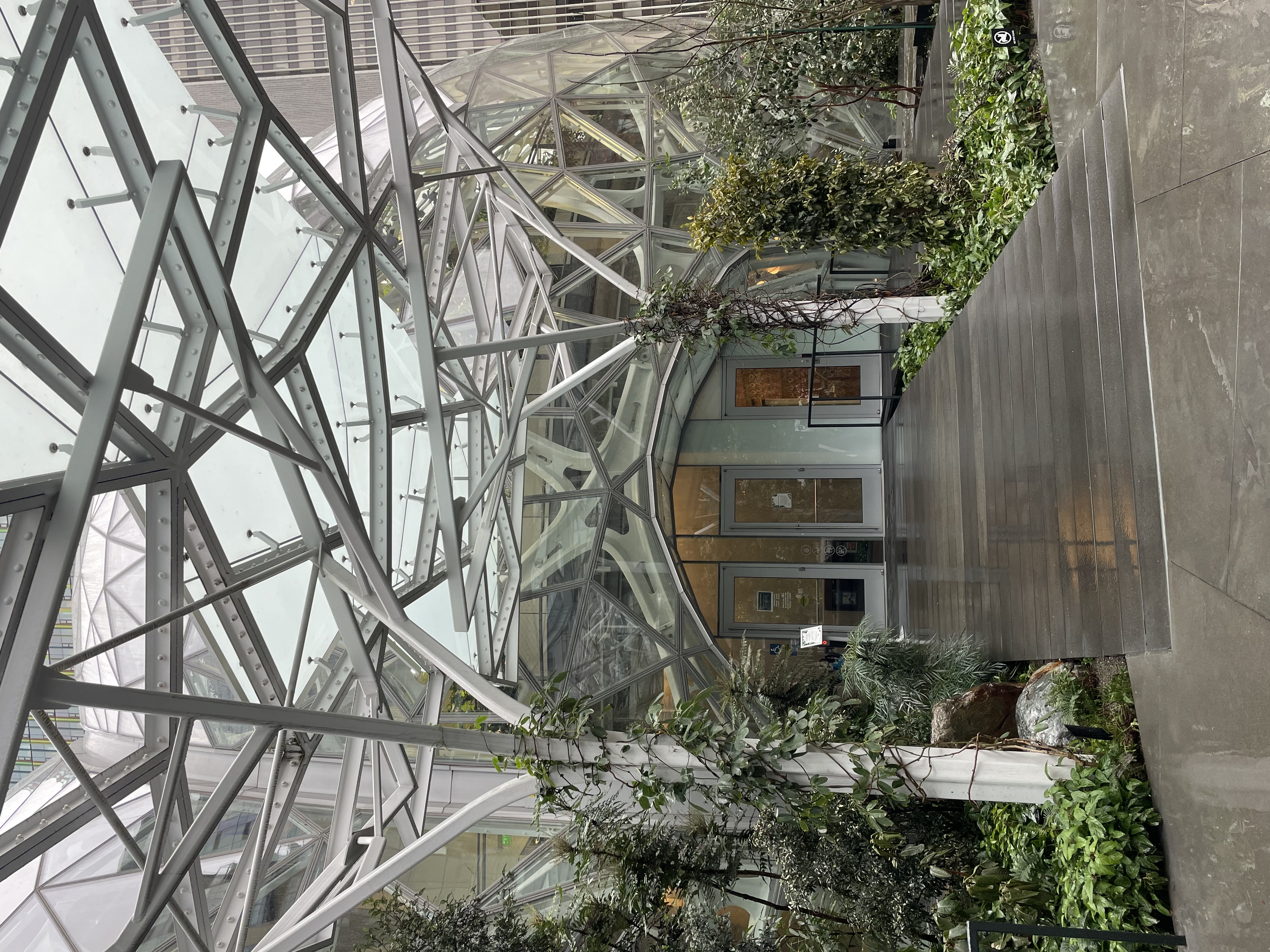
Another entrance, this time to the corporate zone of the spheres. Note that the ground is wet. It would seem that the coverage didn’t function so well, and all the public seating that was “covered” remained damp. Also notice the extensive vegetation that’s been cultivated to grow around the spheres, acting in a way to “naturalize” the spheres. Is the vegetation successful in doing it? Surely in its absence there would be a spacyness and coolness to the whole arrangement. I remain unsure that the vegetation there was successful in naturalizing anything.
(expand on this section)

As I wrap around the spheres, I encounter a dog park. This makes sense, given that Amazon allows its employees to bring dogs to work. It also seems to elevate this principle to a key point of centrality given that it’s given such obvious proximity to the “nexus”—the human dog relationship of amazon employees demands further investigation. Indeed, I can remember when my Dad worked at Amazon he always brought his dog to work. I could ask him further questions about what services they provided for dogs (probably also online), but clearly this is a corporate value at work and one that may pertain upon it’s algorithms albeit in a more indirect way. Perhaps we can surmise that the decision makers at the company find that the human-dog relationship in the office place outweighs any costs it might have? I’m not sure what the calculus is, but the “unusual” nature of amazon’s compassion for dogs was certainly given an elevated status by placing the dog park in such proximity to the spheres. perhaps the dog park was there to be seen—and it’s possible that for example the visiting Japanese businessmen might have noticed the dog park and asked one of their Amazon contacts about it. I can only guess.
In any case, there were three little brown dogs in the park. This was in spite of it being rainy—it didn’t stop their owners from coming out for some air.
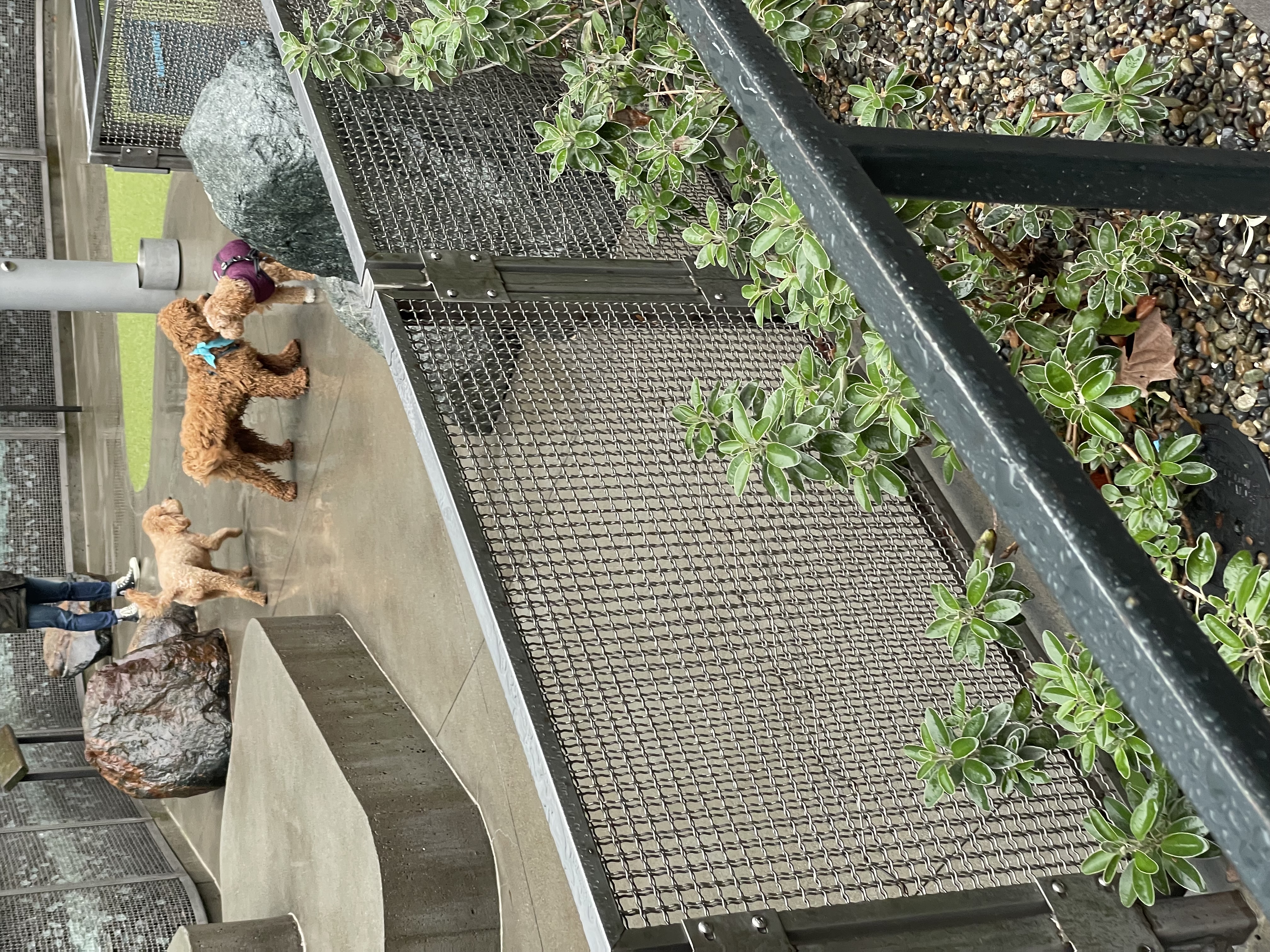
I then turned around and began to get a clearer view of a sphere. 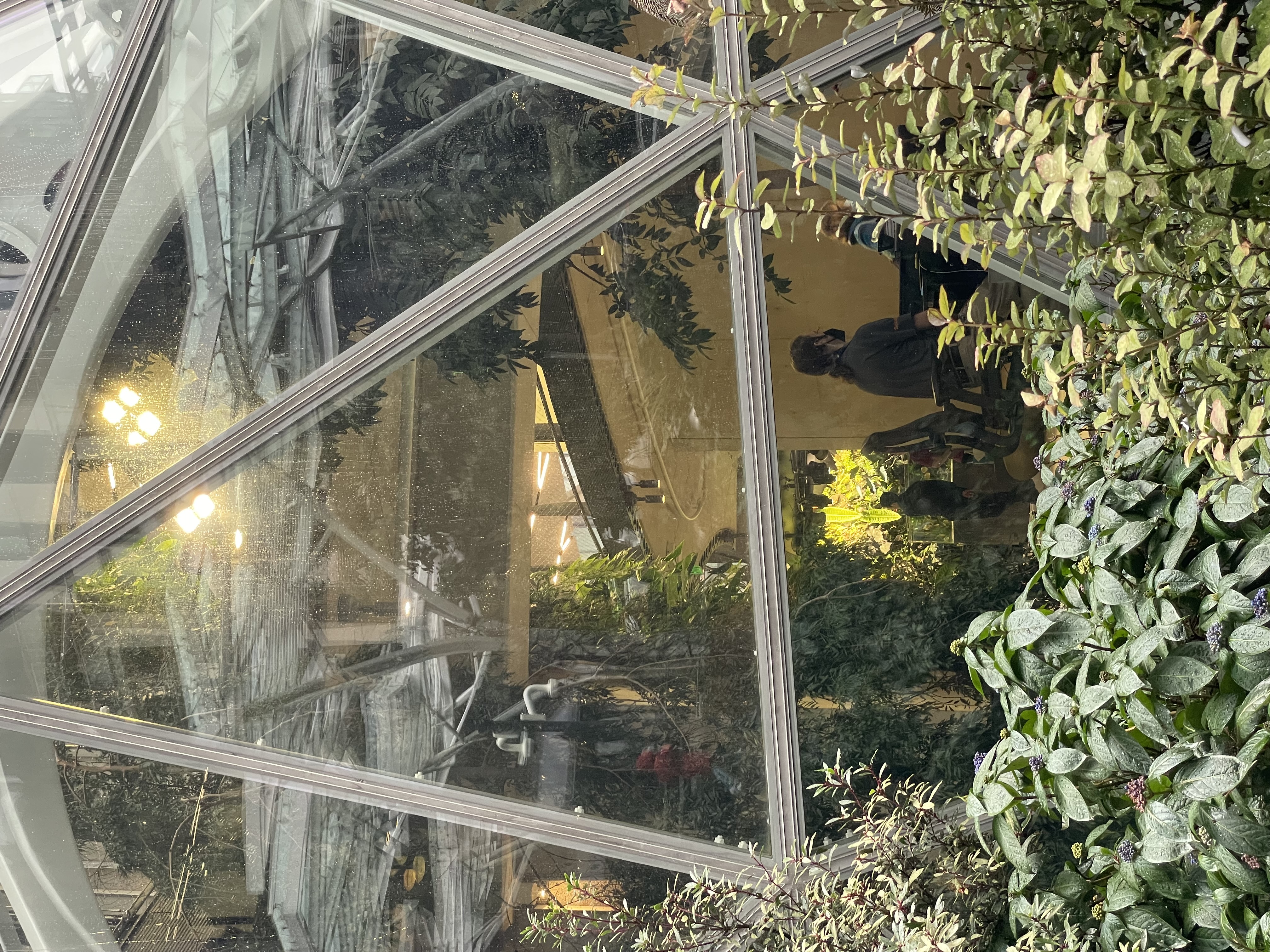
Inside there was more foilage, railways, security personnel at the entrances, and lots of cozy nooks where people could sit with laptops and work. It seemed like a sort of covered park, with plenty of space for staff who wished to take a break from their desks and hide away or meet for a coffee in the more scenic, park-like sphere. Of course I can’t be sure about any of this from looking at some chairs placed on a railway, but this was at least the surface impression that it gave. When I looked at a lower level, I saw a table with a half-dozen people in matching magenta shirts. They seemed to be sitting with lots of gear—technical and otherwise—and seemed like the kind of place one would go to get checked in and logged witihin the massive personnel machine of the enterprise. Principles such as identification, access, resting in a park, a symbol or microcosm, work, security, enclosure—all surfaced when taking a closer look at what was taking place within the spheres.
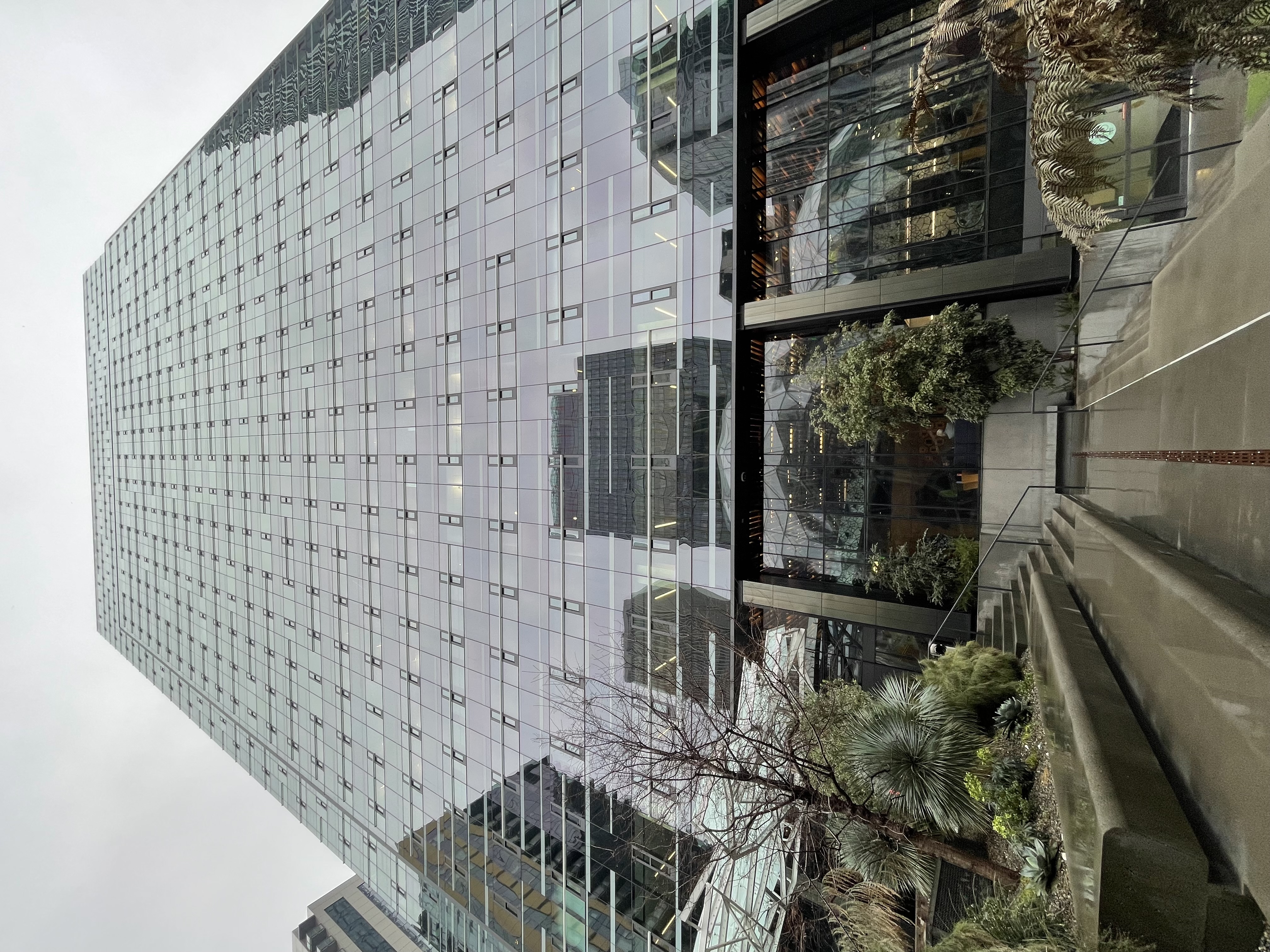
Turning around stood a tall, gleaming black—the business. Behind the glass was a large lobby, and then one imagines, business the rest of the way up. I don’t know what functions of Amazon are in the building, though I imagine a visit with an employee could begin the render it visible. For now, I needed to start to come to terms with what analytic objects these buildings can be on their own without additional human interpretation. Are they enclosures that house what? Surely thousands of people, and just as many computers. How are they being used? Well we know something about the output of the Amazon system, so presumably even in a in the distant and detached way, work was being conducted that contributed to this output. One might imagine a vast network of directives emanating from this building—information flowing outwards by way of updated spreadsheets and code bases—that carries influence over Amazon’s vast network of warehouses and delivery trucks, cyclists, carriers, etc. Or maybe this building is home to AWS and systems are being imagined and maintained here that come to underlye popular companies like Netflix. Again, a node of information flowing inwards and outwards that directs the movements of the people in the building, what they talk about, the decisions they prioritize, the software they load on their monitors to look at, and so on. The building is an enclosure that allows for the intensity of this work to increase—indeed Amazon has mandated that its employees must come in to work at least 3 days a week (source)—suggesting that much like a termite mound, it is here that the work is being executed and this work is entwining and combining, in ways unknown, to contribute to the overall functioning and longevity of the Amazon system. At least, this was how I first thought of these buildings as serving a role in the behavior of the system, and by looking at them in this way, I could start to perceive the flow of people less from the human scale than from the systems-algorithmic scale. It asked me to perceive at the scale of the algorithms, or at least to try, even as the algorithms themselves remained largely out of direct perceptual view in this cityscape.
Between the gleaming black and the sphere was a public space, wet and abandoned, but that would seem like a nice gathering point on a rare sunny day. Below there was a patch of grass—I didn’t check if it was real—and on it was a trailer. The trailer gives employees free bananas, and I could hear music emanating from it. From where I stood, I could see employees with their lanyards approach the wagon and walk away from it with a bundle of bananas. Free bananas are a perk.
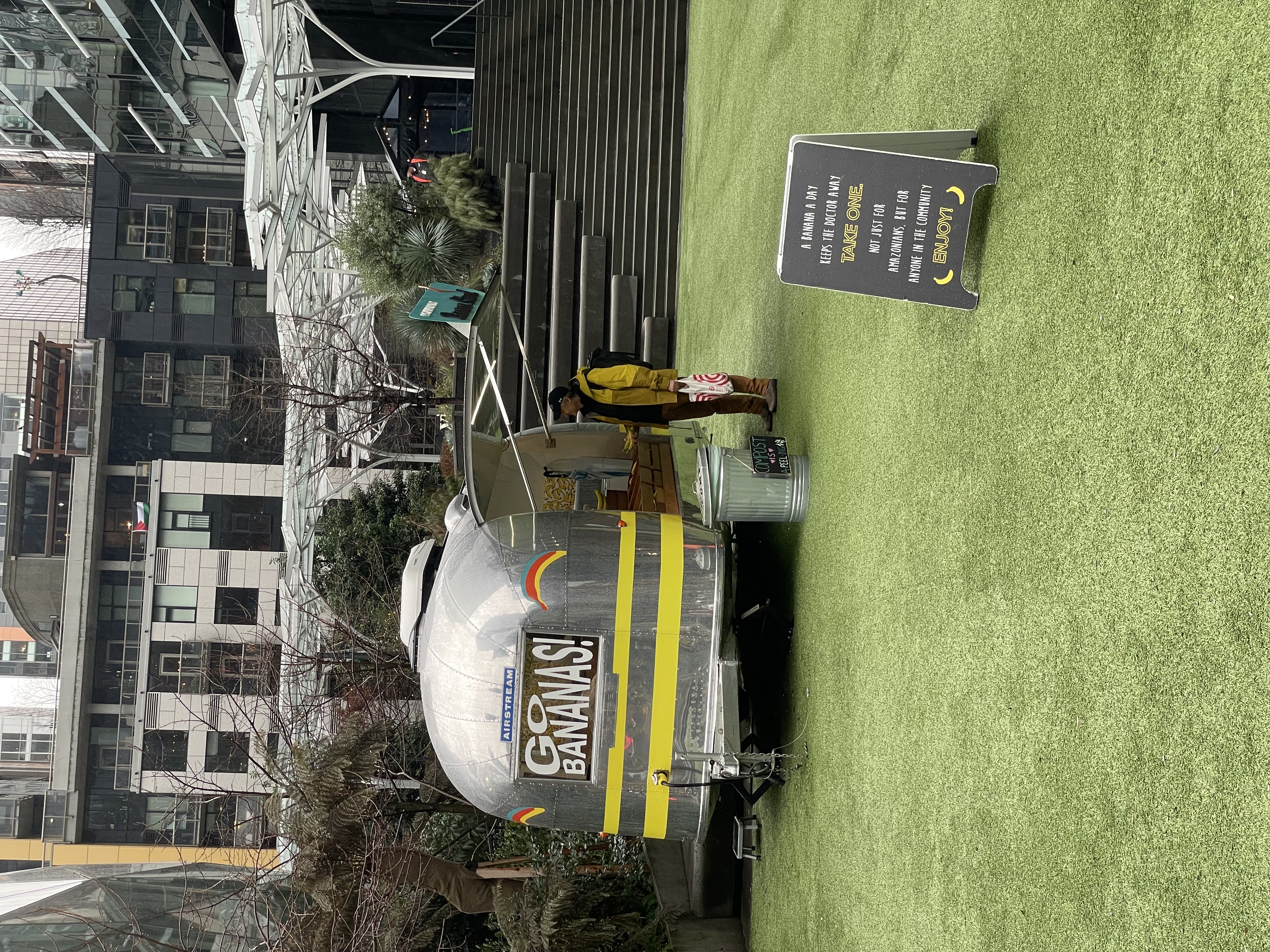
Had I read the sign more closely, I would have realized that even I could have a banana! In earnest, I just thought they were for staff, so I didn’t get nearer. The scene itself was the most cheerful part of my visit. The staff working in the banana cart were dancing and reading books and seeming to be enjoying themselves. I wonder is it a dedicated role to be a banana giver? Next time I’ll need to get closer and ask some questions. I did record a video of the banana cart that I’ll try to attach below
( banana video )
Next I turn to another semi-public space, the Amazon Go store. I decide to venture inside, and am immediately blocked from entering by a robot!
I watch a number of people stand and enter. Some place their palms above it, others their phones. Some have issues with the scanning, like the person in the video above. In my field notes, I write:
- no staff, but big surveillance, wonder if I’m being watched on camera out of view
- mainly Amazon staff, but not limited to
- family came in, hard to tap in, little kid and wife and husband
- entrance robot — like a slow subway turnstile (put recording here)
- music feels like chosen by an algorithm
- ppl scan phone or hand. wonder what it’s like to have your palm logged and recorded by a machine
- nobody talks unless on the phone
I also take a picture of the station whereby one can register their palm
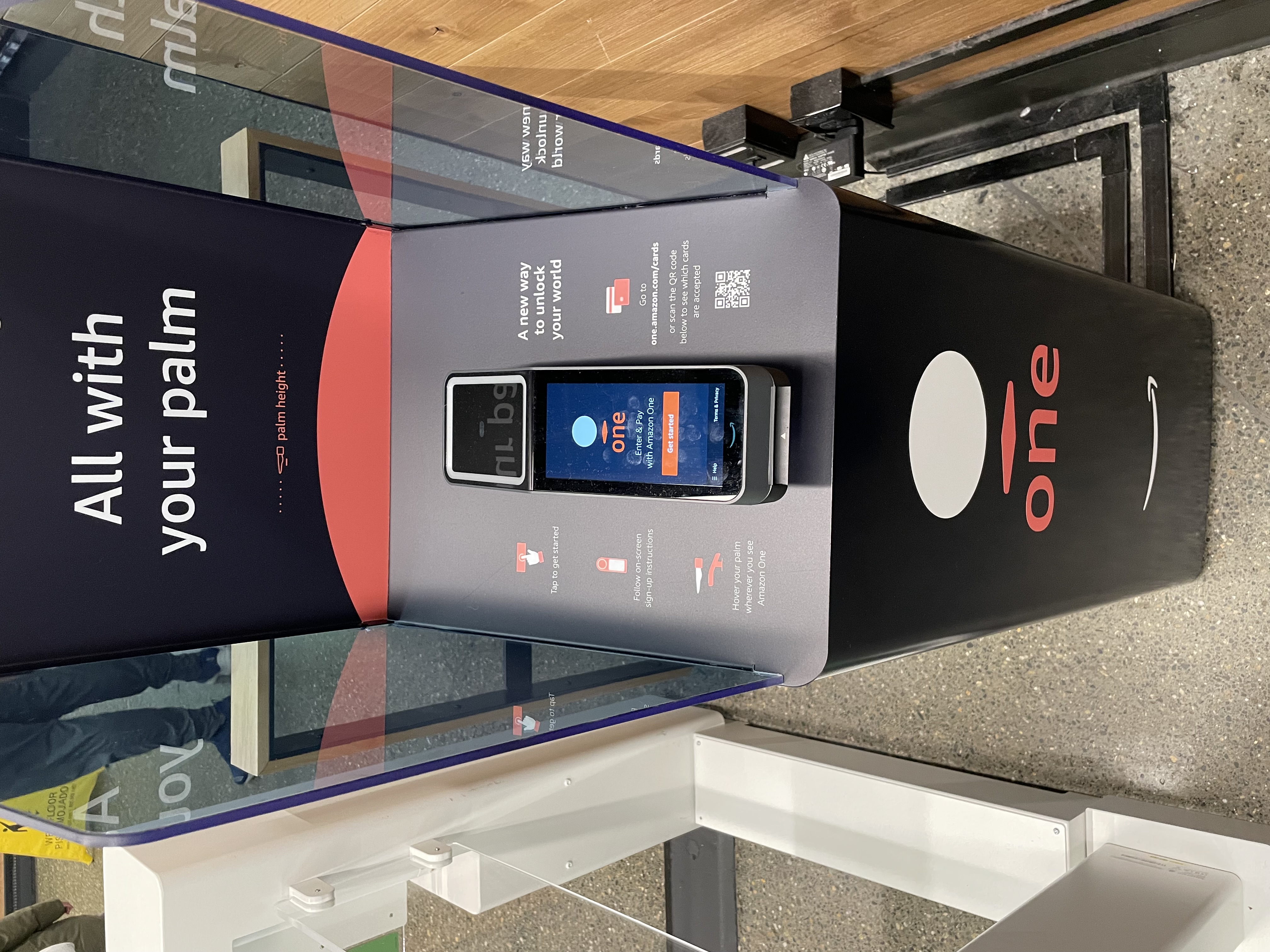
In the store itself there are rows of empty shelves. Some contain takeaway boxes of sandwiches and other snacks for working professionals on the go. There are also large boxes of sodas and other bulk snack foods. I take a water, and notice that all the price tags are electornic:
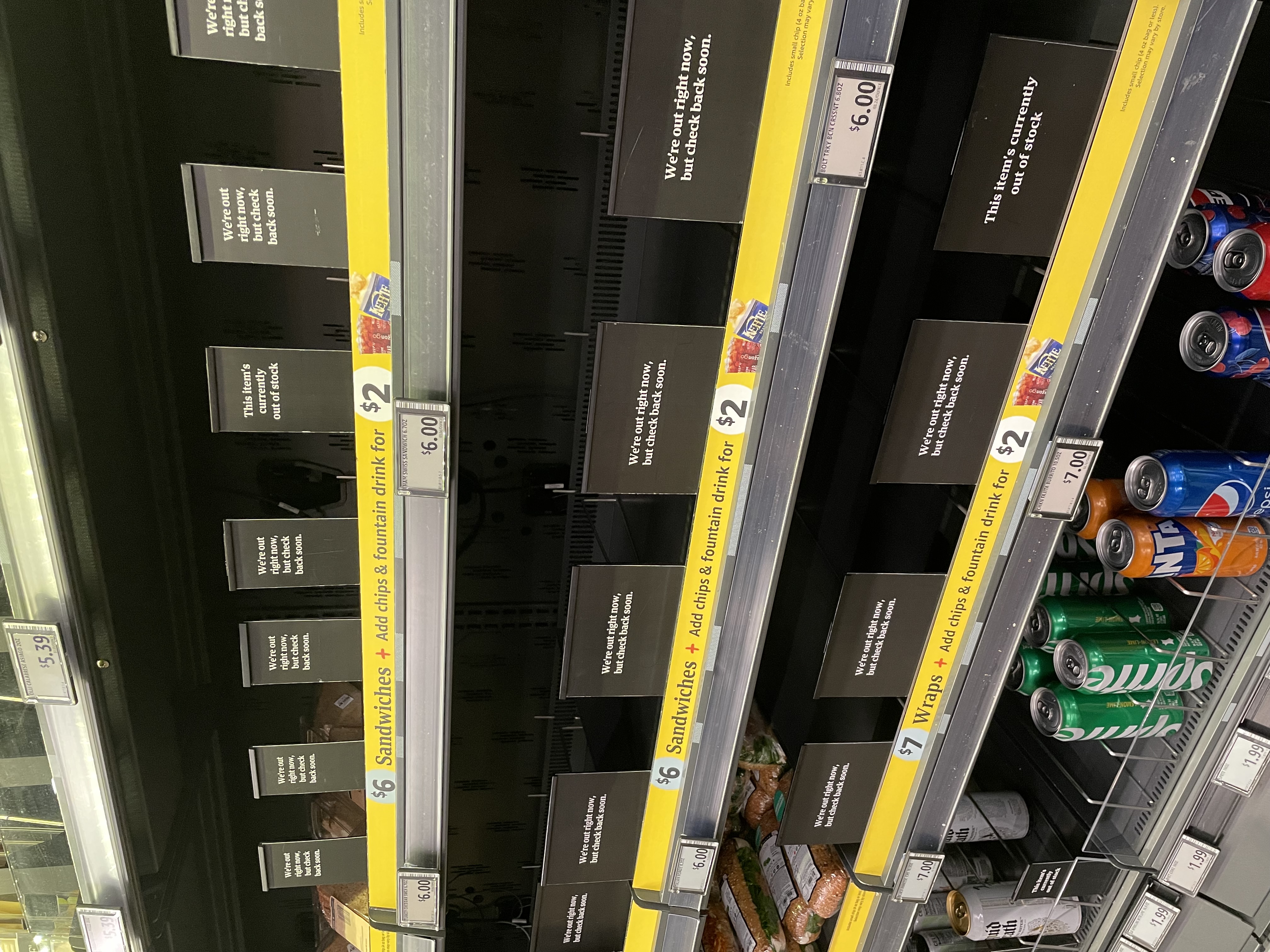
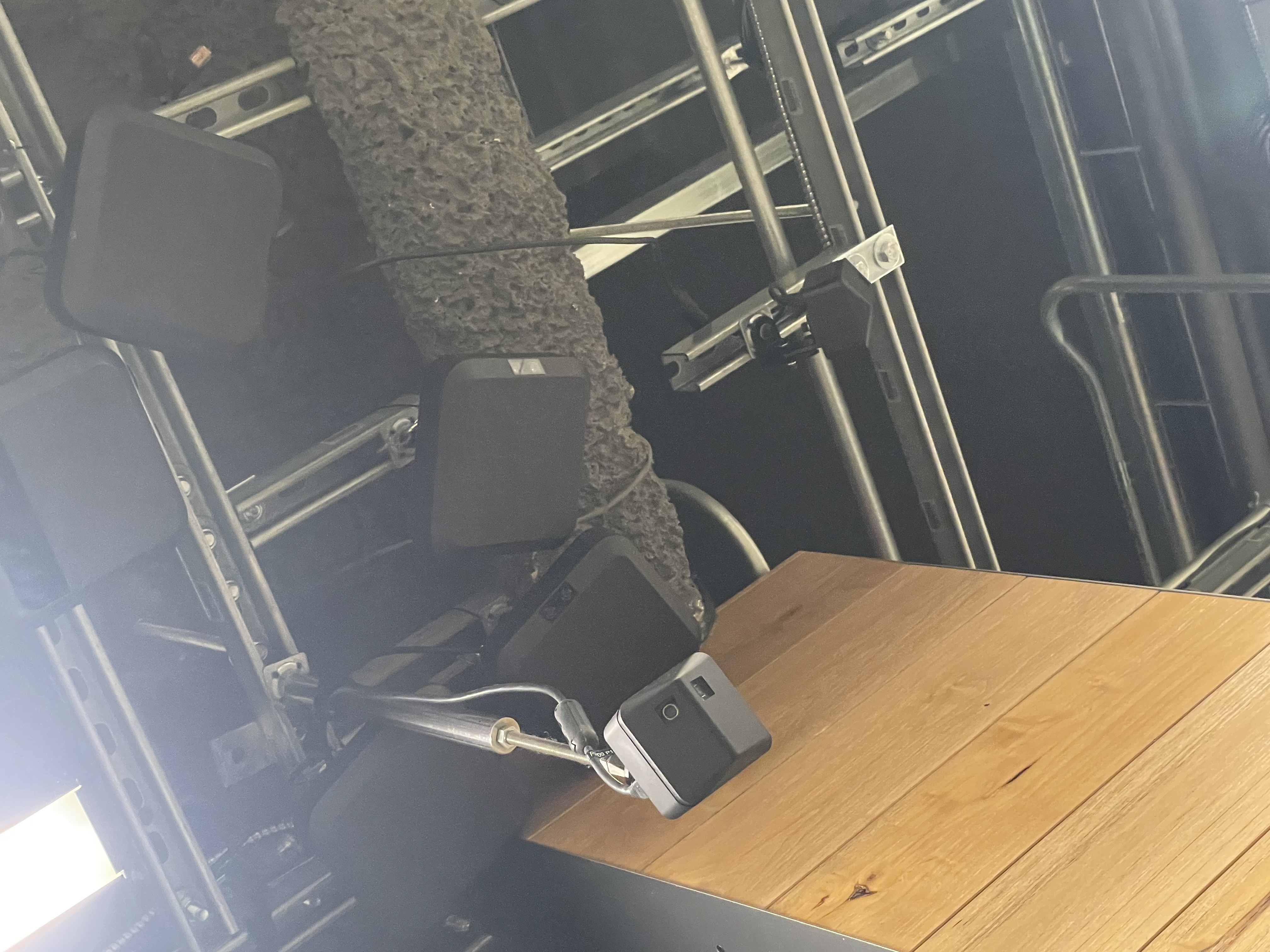
Picture of the surveillance system in place to track who picks what goods.
I pick up a water bottle, peruse the store some more. There are no staff, only an idle station for dropping off amazon packages.
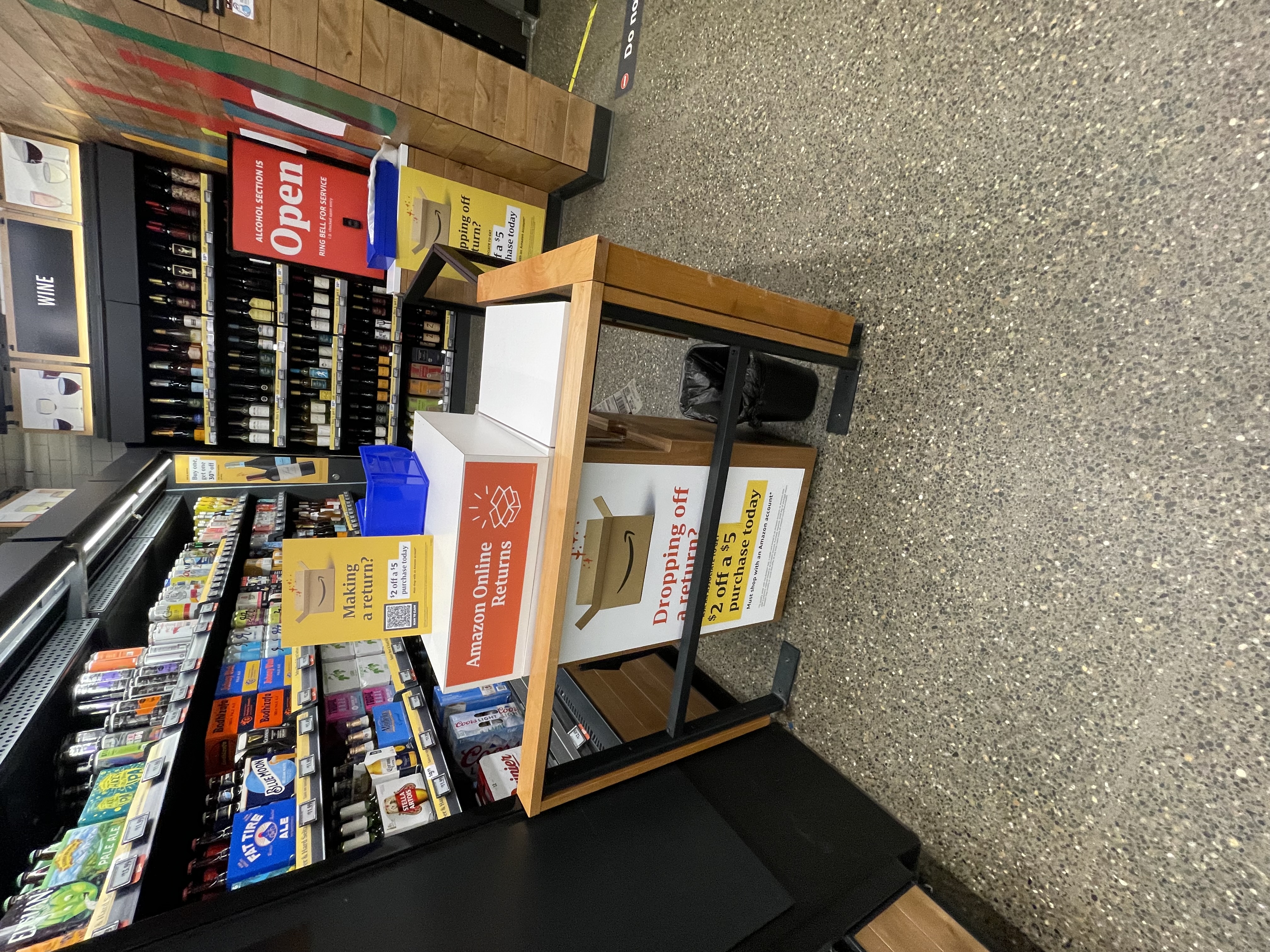

Everything appears automated with booths and screens. People are silent. I carry my water through an exit turnstile. Nothing happens. It feels a bit like I carried it out without paying. I go sit at a small booth area and record a video of a man scanning his palm.
I then proceed to write in my field notes.
- employees recognized by umbrella, badge + lanyard, carrying a banana
- Valet sitting next to me watching Tiktok videos
- Man sits down, black jacket clear glasses, big chocolate chip cookie, scrolls news
- Professional dress of amazon go employees lends a sense of idealization of everything. even the people passing through conform to a model
- Few if anyone is smiling. slightly strict, stressed oppressive corporate atmosphere
After finishing my water and refilling it, I venture back outside.

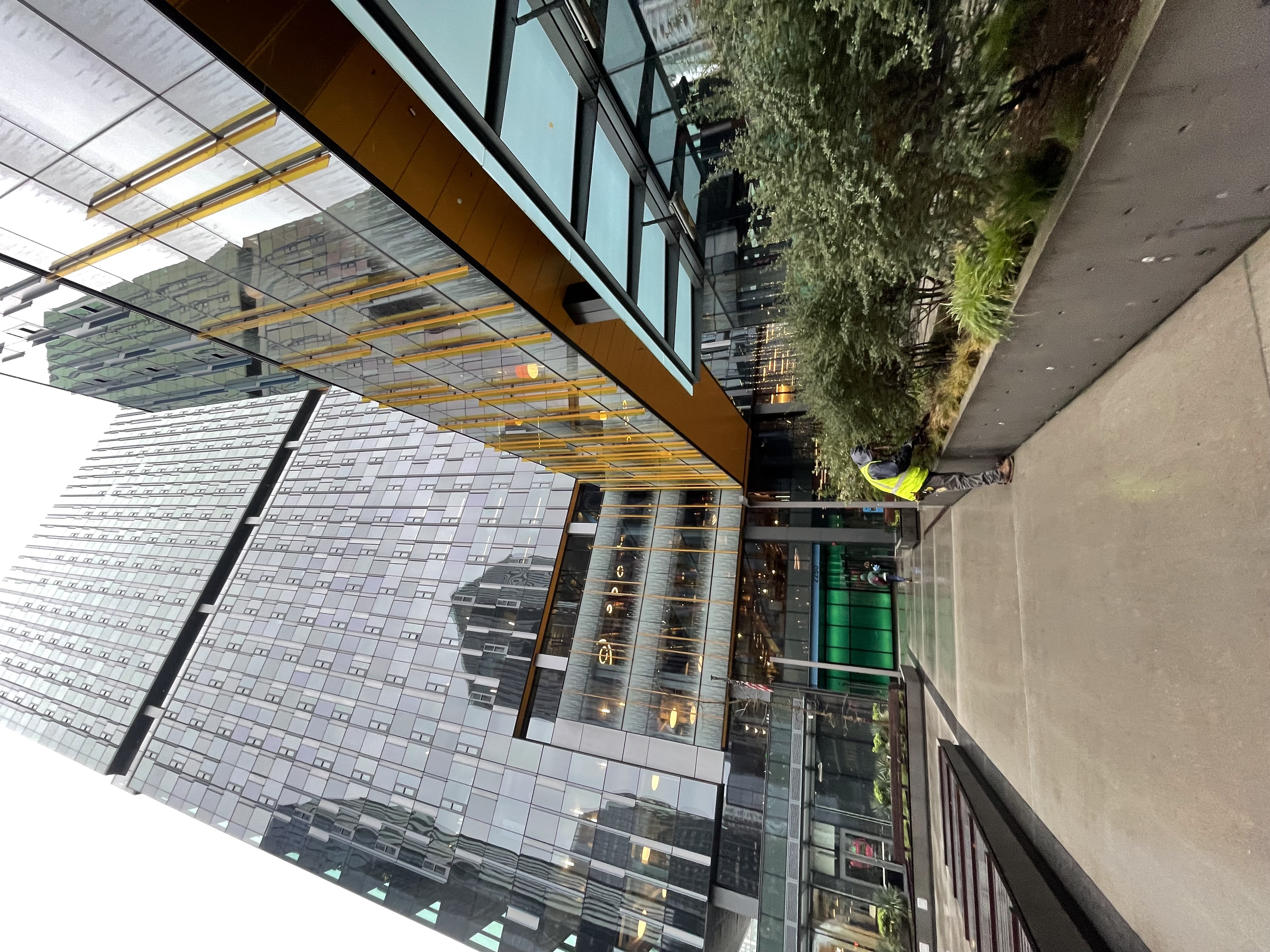
I venture towards another plaza, and realize I’m encircled by these gleaming buildings:

This is as close to the algorithm as I feel on this visit. Each monolith, a gleaming representation of a vast system. Each portrays on its surface the complexity that lies within, the coodinated dance of humans, machines, and operational logics. This picture, more than anything, seems to capture the complexity of the algorithms that radiate outwards of this place. While little is visible on the surface, the buildings reveal themselves as enclosures to the complexity. They protect from the natural elements and the prying public, including myself, but reveal a power. I imagine at the base of these buildings there are server rooms that are pulsing signals outwards to the rest of the Amazon algorithmic empire.
In this video, I capture people coming and going in a skybridge between two buildings.
(video too large to be included)
Excerpts from my notes:
Algorithms — gleaming buildings, dark blue glass and colorful accents. high end restaurants, high end cars, corporate umbrellas, banana cart, even gleaming christmas lights, they brighten the darkness. stressed, pressured conversations, blank, anonymous busses. backpacks and badges.
The algorithm is made of
- people
- buildings
- “place” abstracted away from the homes, warehouses, etc.
- language
- specialized
- general (english)
- economics - incentives
The place itself represents imaginaries
- Amazon Go -> personless store
- gleaming buildings — create a sense of place, amazon as a focused, coordinated entity, feels distinct from rest of surrounding parts of city
- can’t see a recommendation system, but can see people, desks, chairs, servers, software and code bases, corporate security, policies, strategy documents, etc. all come together to create the system -> human-AI assemblage
- what’s the right level of causality to perceive it by? maybe not a human scale
A place necessitated by its algorithms. It exists because of digitized global supply chains, routing algorithms, the organizing algorithms of business. The buildings are present through the business. They may outlast it like shells left by a hermit crab. The anonymous worker—recognizable by the umbrella, lanyard, their presence in this exclusion zone. Recognizable by existing in the locked buildings and entering / exiting them. Anti-open, anti-democratic buildings, even if interstitial zones like the parks are common. Focus on what I saw: Buildings, people, umbrellas, security staff, card readers, restaurants everywhere, natural installations. Amazon Go stores. Buildings - home to business, operations, hr, everything that allows the business to function, software, and the algorithms that run in the Amazon warehouses on robots and machines. The logics that govern the business may be determined here but their effects are felt much further off. Spheres and gleaming HE buildings and expression of the power-distributed power that spreads through computer and logistical networks from this nexus.
Looking at all this, what can we say:
- algorithms are businesses are places
- here they have a discernible architecture
- public showcases like Amazon Go show a future without humans, the pinnacle all of this seems to be reaching for
- absence of people - rain, work from home, etc. many restaurants, all seemed empty. public spaces also mostly filled with people coming and going.
- surprises
- how silent it was, main feature of soundscape was canned music, and the music of the woman dancing in the banana cart
- how joyless of a place it was. a place for work, corporate dramas, for seriousness very little levity visible anywhere. a lot of professionals dressed, serious people.. not sure how to interpret it, but there was a “weightiness” to being there I can’t quite characterize.
- Being in the work zone, people hurry with their Amazon prime umbrellas, serious expressions on a dreary wet day.
Field Notes
